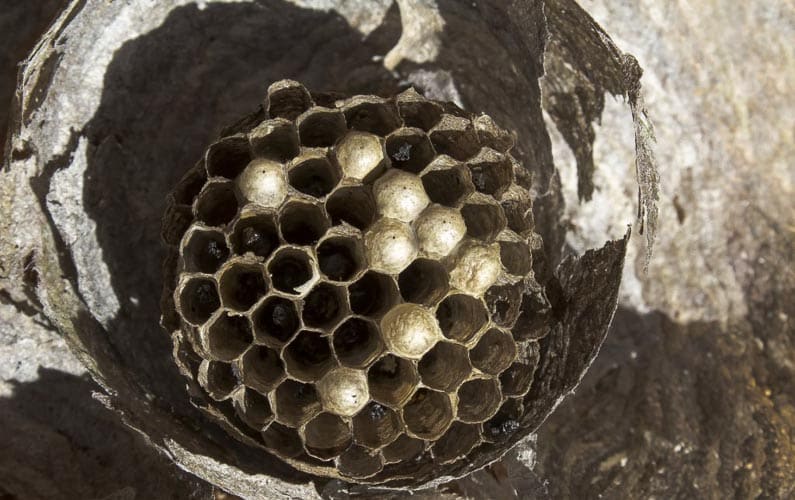Imagine a peaceful evening, the comforting crackle of a fireplace, and the gentle hum of serenity. Suddenly, a sharp buzzing sound pierces the tranquil atmosphere, sending a shiver down your spine. Wasps have found their way into your chimney, transforming it from a source of warmth into a potential hazard. Don’t fret; this comprehensive guide will equip you with the knowledge and techniques to effectively eliminate these unwelcome intruders from your chimney, ensuring a safe and comfortable home.

Image: www.youtube.com
Identifying a Wasp Infestation: Signs to Watch Out For
Wasps, known for their social nature and aggressive behavior, can become a nuisance when they choose your chimney as their nesting ground. Identifying an infestation is crucial for initiating prompt action. Here are some telltale signs to look for:
-
Unusual buzzing noises: Wasps are known for their characteristic buzzing sound, which becomes particularly noticeable around the chimney area.
-
Visible nests: Wasps often build nests out of chewed wood fibers, giving them a distinctive paper-like appearance. Check the exterior of your chimney for any visible nest structures.
-
Increased wasp activity: Noticeably more wasps flying around your chimney or hovering near its opening could indicate an active infestation.
-
Stinging incidents: Wasps are known to sting when threatened or disturbed. If you or your family members have experienced wasp stings near the chimney, it’s a clear sign of their presence.
Understanding Wasps and Their Behavior
To effectively combat a wasp infestation, it’s essential to understand their behavior and habits. Wasps are social insects that live in colonies under the leadership of a queen wasp. Colonies typically consist of worker wasps responsible for gathering food, building nests, and defending the colony.
Understanding wasp behavior can guide your removal strategy. Wasps are most active during the day, especially in warm weather. They are also highly protective of their nests and can become aggressive if threatened. By exercising caution and employing appropriate safety measures, you can minimize the risk of being stung during the removal process.
Removing Wasps from Your Chimney: Effective Methods
Now that you have identified a wasp infestation, it’s time to take action. Here are several effective methods to remove wasps from your chimney:
-
Professional pest control: Engaging a professional pest control company is the most comprehensive and guaranteed wasp removal method. Exterminators have the necessary expertise and protective gear to safely eliminate wasp colonies, including removing nests and applying insecticides.
-
Shop-bought insecticides: Various insecticides are available in the market specifically designed to target wasps. Be sure to follow the manufacturer’s instructions carefully, using the insecticide around the chimney’s exterior and potential entry points.
-
Homemade repellents: Some natural substances have been anecdotally reported to repel wasps, such as essential oils like peppermint or tea tree oil. While their effectiveness may vary, it’s worth exploring these options before resorting to harsher chemicals.
-
Exclusion methods: Wasps prefer to enter chimneys through small cracks or holes. Sealing these entry points with caulk, expanding foam, or weather-stripping can prevent future infestations. Cover your chimney with a chimney cap to further discourage wasps from entering.

Image: fullservicechimney.com
Safety First: Tips and Precautions
Safety should be your top priority when attempting to remove wasps from your chimney. Here are some essential precautions to follow:
-
Wear protective clothing: Wear long-sleeved clothing, gloves, and a hat to minimize the risk of being stung. You may also consider wearing a beekeeper’s suit for added protection.
-
Avoid disturbing the nest: Agitating the wasps by directly targeting their nest can provoke a defensive response. Instead, apply insecticides from a distance or seal entry points without directly interacting with the nest.
-
Be aware of your surroundings: Keep an eye out for wasps flying around the chimney. If they appear agitated or aggressive, retreat to a safe distance and reassess the situation.
-
Treat stings promptly: Should you get stung, remain calm and remove the stinger promptly. Wash the affected area with soap and water and apply a cold compress to reduce swelling. Seek medical attention if the sting causes an allergic reaction or if you experience multiple stings.
How To Get Rid Of Wasps In A Chimney
Preventing Future Infestations: Essential Measures
Once you have successfully removed the wasps, take proactive steps to prevent future infestations:
-
Keep your chimney clean: Regularly clean your chimney to remove any debris or nesting materials that may attract wasps.
-
Inspect your chimney annually: Once a year, thoroughly inspect your chimney for cracks, holes, or other potential entry points. Seal any openings to prevent wasps from gaining access.
-
Use wasp repellents: Certain scents, such as peppermint or citrus, are known to repel wasps. Consider placing wasp repellents around your chimney or in areas where wasps tend to congregate.
-
Monitor wasp activity: Stay vigilant for any signs of wasp activity around your chimney. If you notice an increase in wasp presence or discover a new nest, take prompt action to prevent an infestation.
By following these preventive measures, you can effectively safeguard your chimney against future wasp infestations, ensuring a peaceful and wasp-free living space.







